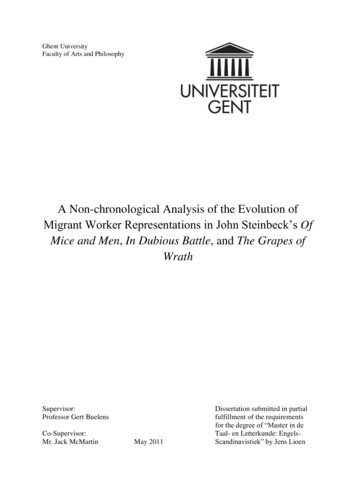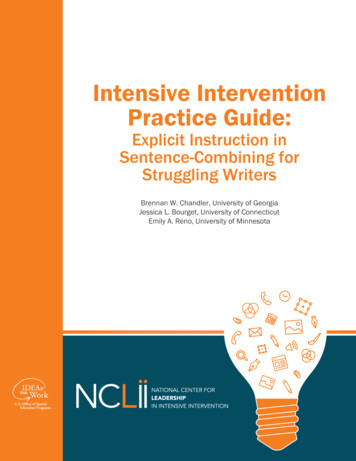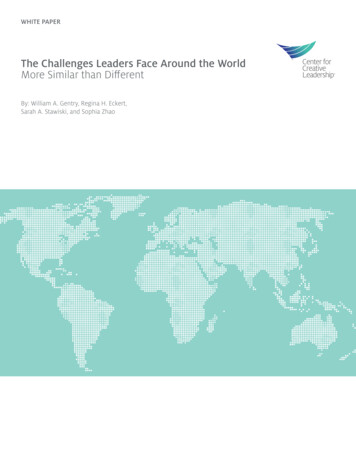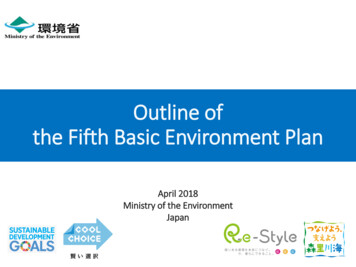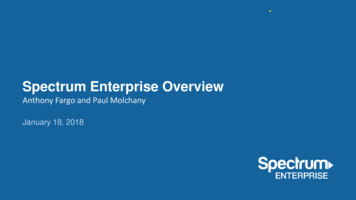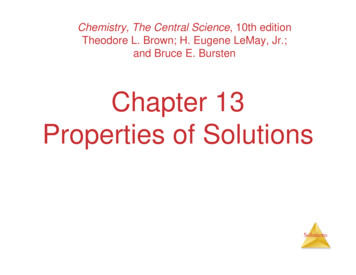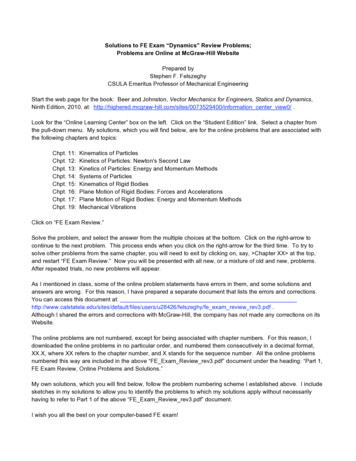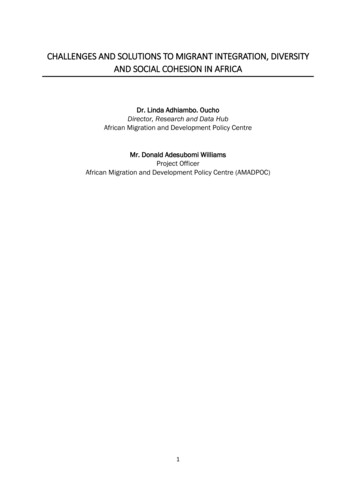
Transcription
CHALLENGES AND SOLUTIONS TO MIGRANT INTEGRATION, DIVERSITYAND SOCIAL COHESION IN AFRICADr. Linda Adhiambo. OuchoDirector, Research and Data HubAfrican Migration and Development Policy CentreMr. Donald Adesubomi WilliamsProject OfficerAfrican Migration and Development Policy Centre (AMADPOC)1
EXTENDED ABSTRACTMigration is the movement of people from their original habitat to a destination outsidethe borders of their origin, purposely to settle and can be voluntary or forced. Theconsequences of migration are usually not predetermined, due to various stages ofuncertainty that may arise, to deter the motive of the migrant to relocate. The presentstate of migration debates is challenging the academic, humanitarian, development andgovernment actors to look at migration differently given that the rhetoric of migration ischanging. Migrants are being viewed through a negative lens instead of agents ofdevelopment to their country of origin or their host country. The historical events sincecolonialism has challenged discussions related to nationalism, and shaped national andregional policies related to migration.When a host community receives forced migrants (asylum seekers and refugees), theyare unprepared to accommodate new entrants, due to the protection of limited sharedresources within their territory, such as land, water, housing facilities, natural andmineral resources. Migrants are often faced with challenges of being accepted by hostcommunities, hence the difficulties in communal integration, harmonious living,commerce, cultural practices, religious beliefs, language barriers, agricultural practices,economic activities, social integration, pastoralism and others. Invariably, conflictbetween host communities and migrants distorts social cohesion and other forms ofsocietal decadence.The border demarcation of Africa in 1885 by colonial powers, was a catalyst toestablishing the sources of recent border conflicts that distort social cohesion, therebyresulting in xenophobia and intolerance between the host communities and themigrants. For instance, the conflict along the border of Rwanda and Democratic Republicof Congo began as an institutional obstruction of Belgian King Leopold who ruled Congo,during the colonial era, to strategically detach resource rich regions and lucrativelandscapes (The Nile, Volcanoes and River Rusizi) from Rwanda and handed them overto the colonial administration of Democratic Republic of Congo. The handing over of theresource rich region to Congo ensured that while the Rwandese migrants are part of theCongo border community, their status will remain as migrants and not indigenes ofCongo, hence as Rwandese migrants, who by the design of the colonial powers reside ina neighbouring country, cannot own land and have no claims to the natural or mineralresources within their former territory. The ethnic identity of the Rwandese migrants isquestioned by the Congolese, whenever there is dispute over land utility and ownership,which led to several armed conflicts and inability to sustain social integration with theCongolese.The province of Bufumbira was also cut out of Rwanda and handed over to Uganda,during the colonial era but the Ugandan communities have had successful relations withthe Rwandese migrants and have been socially integrated into the Ugandan societies.Refugees from war torn nations in East and Central Africa, residing in Uganda have beenwarmly accepted by the host communities as well as the Uganda government, whichestablished a sustainable integration program for the refugees by issuing land to refugeefamilies for farming. This integration plans have resorted to peaceful integration betweenthe migrants and the host communities, as well as generated economic opportunities forthe migrants, whereby, they can produce crops and trade them within the local markets.2
In other cases, migrants contribute significantly to Regional Economic Integration,whereby the migrants are the agents of economic diversity through cross-border tradeactivities.There are also positive benefits of hosting migrants. Cross-border trade contributes tothe Gross Domestic Product of the host state, as well as improve the social and culturalrelations between the migrants and the hosts. Cross border trade is more pronounced inthe West African region, especially between Nigeria, whose population is above onehundred and seventy million. The countries that border Nigeria rely heavily on crossborder trade between their countries and Nigerian border communities. However, thesocial and economic benefits accrued are at par with emerging security threats alongborder communities, such as human trafficking, smuggling of contraband, proliferation ofsmall arms and light weapons and narcotic trafficking. It is widely argued, criminalorganizations operating in the region are mostly residing in border communities, wheremobility is not a hindrance to their escape when they operate between two countries.Crime along border communities such as Badagry, which borders Republic of Benin andNigeria has created resentment between members of the community and the migrantswho are engaged in crime.It is widely argued that when states cooperate economically, they are less likely to beconflict, suggesting that migrants are Ambassadors of peace, contributing to the goodneighbourliness and strengthening regional integration. The trade integration objective ofthe East African Community (EAC) has spurred economic migrants within the region,which has given the leeway for the migrants to extend their businesses across borders,thereby creating new jobs for host communities as well as improved social cohesionbetween the migrants and their hosts. The underlining motive behind economicintegration is to develop the atmosphere for countries to integrate markets as well asimprove socio-cultural relationships. Both agendas are conducted by migrants.Nevertheless, forced migrants may be unable to contribute in equal measure asvoluntary migrants within the host community, due to the psychological effect of war ontheir productive capacities but also their lack of access to resources within the hostcountry.Both voluntary and forced migrants contribute to the cultural diversity of hostcommunities through social interaction, which may be accepted or repelled. Hence, theirrelations could be a catalyst for development or conflict. Intra-cultural relations mayresult in racist or xenophobic attacks, especially when opposing ideologies are consistentin the lifestyle of the migrants who are of a different race, as witnessed between Somalimigrants hosted in different countries across the globe. In the case where both migrantand hosts are of similar race, the resentments would qualify as xenophobic. South Africais an example of a state that experiences xenophobia and racism concurrently. The whiteand black race in South Africa are constantly conflicting over economic resources, whilethe black race of South Africa is also in conflict with other African migrants, depictingxenophobia.Kenya presents a clear example of racism, xenophobia, intolerance, social cohesion,integration and diversity. When Kenya began developing its railway, the Indians werecontracted to build the network as well as maintain them, which meant their settlement3
in the country. These rail workers became citizens of Kenya and has since become thelargest non-African community. However, their settlement brought about racism, which isdominant in their relationship other race, till date. Kenyans have also been xenophobicwith other Africans, especially the Somalis who dominate the North-Eastern part of thecountry. The diverse ethnic groups exhibit intolerance between them which has hinderedthe prospect of nationalism after its demise, after independence. Intolerance is widelydisplayed among in-migrants when they are either in transit or converge with other tribesin urban cities.The Dadaab and Kakuma refugee camps in Kenya demonstrates integration betweenhost and refugee communities. However, the recent insecurity in the country has led to agrowing negative perception concerning Somali refugees and migrants. Kenya has aDadaab hosts majority Somalia refugees while Kakuma hosts South Sudanese,Congolese, Ethiopia, Eritrean and asylum seekers and refugees from other countrieswithin the region. The refugees face challenges in the labour market as they are notallowed to work without permit, which is too expensive for refugees. This is particularly achallenge for heads of households, as they are not capable of providing for their families,which leaves them with little choice to make ends meet. Unemployment is a root causeof crime amongst refugee populations in Kenya, as the lack of work permits leads youthto engage in criminal activities, such as armed robbery, proliferation of small arms andlight weapons. Insurgent recruitment and human trafficking. All these crimes disintegratethe social cohesion within the host communities, as well as creates intolerance, whichleads to xenophobia.Xenophobia is on the increase in Kenya, as a result of the stigmatization of the Somalipopulation from North-Eastern Kenya and Somalia. These population of migrants aretagged with terror related offences and allegations, which taints the image of the entireSomali indigenes living in Kenya. In contrast to the xenophobic relations between theSomali and the Kenyans, trade integration is on the increase, however social integrationis taunted by xenophobia. Many Kenyans would not let out their properties to the Somalisbut the Somalis would let out their properties to Kenyans. The purpose of this paper is toassess the existing studies on the state of migrant integration, diversity and socialcohesion in Africa, drawing examples from the current events under way in different partsof the continent in relation to migration. The paper will draw connection from, forexample, countries that have a history of xenophobia and compare with countries thatare showcasing evidence of xenophobic tendencies and provide solutions to curb thisissue.4
INTRODUCTIONThe decision to migrate is often accompanied by several preconceived expectations,especially that of acceptance by hosts, but with forced migration, the decision is oftenabrupt, to escape death, famine, and many other fatal conditions (Haug, 2008). Theduration it takes a migrant to adapt to the new environment determines how soon torealise integration with the society. Some migrants tend to adjust sooner than others,through social interaction and engagement in economic activities (Botero, Weissing,Wright, & Rubenstein, 2015). However, not all migrants are warmly received by the hostcommunities or are allowed to enjoy similar privileges with members of the hostcommunities. In such instances, migrants become segregated amongst host populationor marginalized from economic activities, especially if they are refugees.Most host communities are not receptive towards refugees, for fear of losing scarce andvaluable resources, such as land (Ediev, Coleman, & Scherbov, 2014). Although,Uganda1 demonstrates a different scenario of hosting refugees and has been seen tohave the most progressive refugee policy. According to UNHCR, Uganda registered morethan 200,000 refugees with UNHCR in 2030. (Lyytinen, 2015) This figures otherwisestrengthened the urban economy as opposed to refugee situations in Kenya, whererefugees contribute to the insurgent activities at the North-East of Kenya, which bordersSomalia. Insurgents from Somalia have camouflaged with residents of north easternvillages, who are also Somali, creating challenges for the state security agencies inidentifying who was Somali resident in Kenya, and who was a new entrant, migratingfrom Somalia (Anderson & McKnight, 2014). The number of refugees hosted in Ugandahas increased since the announcement by the Government of Kenya to close DadaabRefugee Camp due to insecurity.According to the Women's Refugees Commission (WRC), the urban refugee community ofKampala is divided into two wealth groups; "vulnerable households" and "strugglinghouseholds". Uganda allocated plots of land in rural areas to refugees for Agriculture, inline with the Refugee Law Project (2005). Although, the authorities controlled themovements of refugees leaving the camps. Movement out of the camp was restricted tothose seeking medical attention in Kampala, security concerns, pending resettlement orproven self-sufficiency. Since 2006, the government has allowed only few refugees leavethe rural settlements (Urban Refugees Organization, 2017). This has created afavourable living condition for refugees, where they can earn an income as well as remitfunds to the families left behind. Most of the refugees have made enough money torelocate to urban areas such as Kampala, whereas, some refugees migrate to Kampalato seek employment opportunities or engage in informal trade. Majority of these refugeesreside in informal settlements in Kampala, where they contribute to the rise in urbanpoverty and the swelling of slum population. According to the UN data, 2010, children ofpoor refugees residing in Kampala, are not registered in schools, due to the high schoolfees (Dryden-Peterson, 2006).Uganda has signed the 1951 Refugee Convention, 1967 Protocol, 1969 OAU Convention Governing theSpecific Aspects of the Refugee Problem in Africa, 1960 Uganda control of alien refugees act, 2006Ugandan refugee act, which allows refugees to choose to settle in Kampala, or elsewhere15
Migrants tend to display diverse cultures within the host communities. Countries thatattract migrants from several geographical regions, tend to enjoy a myriad of culturesthat enriches the society, although not all cultures are accepted by the hostcommunities. Some cultural practices are considered extreme and inhuman, as such themigrants are mistreated. Notwithstanding the negative impacts of migration on hostpopulations, there are some instances where the host population benefit immenselyfrom the migrants through cultural assimilation and induction of new economic practices(Skeldon, 2001).Social cohesion2 is induced by certain values such as trust, equity and respect. However,these elements are not always present in every situation. Some societies displaycohesive tendencies for a limited period, while pursuing a common agenda and disperseas soon as they meet those objectives. This has been the nature of African societies,prior to independence. Most of the ethnic groups united to force the colonialadministrators out of power, to gain independence. Following the independence, theyretracted to their ethnic communities and begin to contend for the seat of powerindependently through party systems. This has also resulted in inter-ethnic disputes,nepotism and entrenched ethnic affiliations in election polls, as evident in Kenyaelections, where the electorates vote for politicians from their enclaves (Hassan, 2017).MIGRANT INTEGRATION WITHIN HOST COMMUNITYAssimilationThe decision to cross an international boundary for the purpose of relocation, presentsvarious opportunities as well as challenges. The foremost challenge a migrant encounteris culture shock, which is often caused by initial physical experience on arrival atdestination. The culture of host communities often differs from that of the migrant, hencethe difficulties in adapting to the language, religion, values and lifestyle choices of thehost community. The challenges in assimilation are experienced by both host andmigrants. The hosts may not easily comprehend the culture of the migrant, hence theresistance in accommodating migrants, especially refugees (Whitaker, 2015).In the case of refugees, they are escaping volatile conditions and do not choose wherethey relocate, as such, they have no predetermined expectations or preparedness whilecrossing international borders (Gibney, 2015). They suffer mentally stablility, thereforetheir assumptions, expectations as well as the outcomes of their residence within hostcommunities are new experiences. Some refugees, however are inflicted withpsychological trauma, due to conflicts in their home countries. Therefore, are withdrawn,hence, not sociable on arrival at the host community (Familiar, Hall, Bundervoet,Verwimp, & Bass, 2016). For example, former child militants, who have been forced tokill close relatives to qualify for recruitment in the militia as evident in Sierra Leone CivilSocial cohesion is described as the outcome of a combination of harmonious interactive activities amongsta group of people living in close proximity, purposely advancing the interest of all those involved (Bourne &Solomos, 2007)26
War (1991-2002)3. After the war, these child militants crossed the border to join theirrelatives in neighbouring countries without going through any rehabilitation ordemobilization and disarmament program (Derluyn, Vindevogel, & De Haene, 2013).They resumed civilian life with a distorted mindset, which reflects on their relativecapacities with host communities. Some have been known to join or form rebel groups inthe host communities, thereby, contributing their combat skills and expertise toescalating conflicts, as in the case with the Niger-Delta militants in Nigeria (AdeyemiSuenu, 2014). The Niger Delta Liberation Front (NDLF) and the Movement for theEmancipation of the Niger Delta are fighting side by side to overwhelm the Nigerian Army,in an ongoing battle to secede from Nigeria. It is widely known among the Niger Deltacommunities that the militants are from neighbouring countries, such as Liberia andSierra Leone (Aghedo & Osumah, 2015).Female refugees face more psychological challenges while settling down in hostcommunities, due to mental and physical injuries sustained from rape during conflicts intheir countries (Kohli, et al., 2014). For example, female refugees from South Sudan, aremostly victims of rape, due to the rampancy of the gory activity during the prolongedconflict. Majority of women from the Upper Nile State of South Sudan, living in Akoka,Bailet, Fashoda, Longochuk, Maban, Maiwut, Malakal, Manyo, Melut, Luakpiny / Nasser,Panyikang, Renk and Ulang have fallen victims of rape by militants (Tankink, 2013).These human right violations, destroy the productive capacity of refugee women in hostcommunities, due to injuries sustained from rape, such as damaged uterus (Benshoof,2014). In addition, men from those communities marry outside their community, andtherefore not extending their lineage in the host communities (Clark, 2014). Theperceived motive behind rape is to ensure the victims are not capable of reproduction,and never willing to return to their homeland, due to fear, trauma and stigma. Thisimplies that the militants’ objective of rape was to control population growth throughrape. This in fact is an act of genocide and a gross human right violation (Chapleau &Oswald, 2013). Despite international conventions against rape, militia groups as well asthe South Sudan military consistently violate the provisions of international law. Articles3 and 4 of United Nations Security Council Resolution 1820 (2008)4.Employment OpportunitiesMigrants have very high expectations that may not be fulfilled at destination, hence, thedisappointment and frustrations that ensue (Creighton, 2013). The first expectation of amigrant is to secure a meaningful job for immediate sustenance while they seek moresustainable opportunities. Migrants often to consider the probability of findingemployment in the host country overlooking potential barriers that may prevent access toRebel groups fighting against the then President, Charles Taylor, (Patriotic Front of Liberia, NPFL) inpartnership with the Revolutionary United Front (RUF) of Sierra Leone joined forces to overthrow thegovernment of Joseph Momoh (Borisova, Betancourt, & Willett, 2013).4The UNSCR “demands that all parties to armed conflict immediately respond appropriately to protectcivilians, including women and girls, from all forms of sexual violence; Article 4. notes that rape and otherforms of sexual violence can constitute a war crime, a crime against humanity, or a constitutive act withrespect to genocide;" (Kirby & Shepherd, 2016)37
the jobs they desire. They often ignore an assessment of the nature of the labour marketbefore migrating. Some labour markets do not permit migrants, due to the limitationsthat exist, such as an overwhelming labour market, youth bulge, limited vacancies andgovernment restrictions. Migrants are usually not permitted to work with their visitors’visa in many countries, which is a reason for migrant engagement in criminal activities,as a resolve to generating income for themselves and for the families left behind(Menjívar & Lakhani, 2016).Existing immigration policies at country level would have to be reviewed and wherenecessary revised especially countries that attract labour migrants. This review will notonly reduce the chances of migrants becoming undocumented and working with the riskof being deported, but will also endeavour to respect international obligations such asthe United Nations 2030 Agenda Sustainable Development Goals (SDGs) through itsMembers States. It aims to create conditions for sustainable, inclusive and sustainableeconomic growth, shared prosperity and decent work for all, importantly identifiesmigrants as vulnerable people who must be empowered and whose needs are reflectedin the Agenda to end poverty in all its forms everywhere, protect labour rights andpromotions of safe and secure working environments for all workers, including migrantworkers, in particular women migrants, and those in precarious employment with specialattention on forced and child labour.The UN Member States also agreed to ensure that all migrants will be allowed to movesafely and responsibly (Colglazier, 2015). Unsafe migration distorts social and economicdevelopment and often lead to the exploitation of migrants. Exploitation of migrantsoften begin at origin, where they are recruited for several informal labours in othercountries. Their ignorance to international norms leave them vulnerable to thetraffickers. Discussions at a global level has already began through the Global Compacton Safe, Orderly and Regular Migration through regional consultations to outline some ofthe key issues to be considered An example is the trafficking of teenage girls from BeninKingdom of Edo State Nigeria to Lomé, Togo. The traffickers take the young girls throughthe West African borders to Republic of Togo for orientation, which includes practisingprostitution. They are held there for several months until a host in Italy or France isprepared to receive them (John & Faith, 2015).Women and girls make up the majority of migrants globally, as a result of thediscriminations they face in their country of origin (Gallagher, 2015). Discrimination ismostly found in sub-Saharan African countries and other developing countries across theworld. Patriarchal perceptions borne to the societies where these women reside generateexpected roles and responsibilities by gender with women playing a more private role andmen a public role. These perceptions of African women playing traditional home makerroles have been challenged through feminist movements from the developed countries,which assume that this situation as enslavement and thus initiate programs to enlightenAfrican women and their community to be self-sufficient and independent of men in thesociety (Allen, 2016). African women have been able to participate in employment andbecome self-sufficient as they contribute to the household economy while at the sametime taking care of the home by recruitment house helps. This has often resulted intensions between husband and wife as two divergent views on gender roles within the8
household and in the public sphere would lead to broken households (Yoon, et al.,2015).Those female migrants that play a more traditional role within the household wouldexperience difficulties socializing with a host community where women contribute to thehousehold economy and are self-sufficient. They are bound by culture to remain at home,therefore limiting their exposure to the host community which may lead to alienation dueto cultural differences. Their contribution to development is often indirect, as they havetransferred the culture of not working in public, hence, they neither generate revenue norpay income taxes. However, many have argued that their contribution to the home canbe quantified and assessed for productivity and societal development. The home isconsidered a fragment of the society, therefore if the home is not in order, the entiremembers would be considered to be living in chaos. The chaotic living conditions are notfavourable to the mental health of those members of the family who contribute to publicdevelopment. And as migrant families, they will be inconsistent at work, which may leadto losing their jobs (Abdi, 2014).HousingHousing is usually a major concern for migrants in terms of finding the rightneighbourhood that is safe for their families, affordable with good transport links. Majorcities which are primarily destinations for internal and international migrants offerdifferent types of housing depending on affordability. Those migrants that are financiallyconstrained, often seek informal accommodation in congested areas, such as slums,which are mostly affordable. The increased slum population impacts on availableinfrastructure, such as sewage, water supply, medical services and sanitation services.These services are in short supply to informal settlements, due to the unplanned andunstructured living situations within informal settlements that do not meet requiredstandards of the city council (Mberu, Ezeh, Chepngeno‐Langat, Kimani, & Oti, 2013).Refugees are not privilege to enjoying similar benefits as other migrants, who have achoice to where they reside. Refugees are settled in host communities determined by thegovernment where they have access to social services provided by a number ofinternational agencies such as UNHCR, World Health Organisation and UNICEF. Theirmovement is managed by the government and UNHCR and in some countries, such asUganda and to a certain extent Ethiopia, the refugees have the right to seek employmentand opportunities in other locations within the country. Kenya hosts the largest refugeepopulation in the world in two major camps, namely; Kakuma Refugee Camp5 andDadaab Refugee Camp6. Since the inception of the camps, the refugees have mixed withthe host population and intermarried with them, to nationalize their immigration status(Oka, 2014). Refugees who integrate with their families who reside legally in Kenya, findKakuma Refugee Camp was established in 1992, located in Turkana County, the north-western region ofKenya, 95 kilometres from the Lokichoggio Kenya-Sudan border. It hosts about 60,000 refugees fromSudan, South Sudan, D.R. Congo, Ethiopia, Eritrea and other nationalities6Dadaab Refugee Camp was known to host one of the largest Somali refugee populations until theannouncement to close the camp was made in May 2016. Dadaab hosts about 260,000 refugees fromSomalia, located in a semi-arid town in Garissa County, Kenya. It hosts refugees in five camps (Dagahaley,Hagadera, Ifo, Ifo II and Kambioos). The camp is run by the UNHCR and funded by foreign donors.59
it much easier to socialize with host communities and assimilate Kenya cultures fasterthan those who have no relative in the country. Those with families residing in Kenya,assist in domestic chores, and by so doing, contribute to refreshing their kin of theirnative cultures by cooking native foods and speaking native language around the house.Children in such situations, learn their cultures and adopt their traditional values in theirlifestyle (Gilhooly & Lee, 2014).DIVERSITY OF MIGRANTS AND HOST COMMUNITY (POSITIVE AND NEGATIVE)Migration ensures the transfer of different cultural norms and values to the hostcommunities, which is sometimes rejected, especially if the cultures seem to be extremeto the belief system of the host community. An example is the circumcision of the girlchild, which is a norm in many African societies, but is currently been challenged at anational level as it is viewed as Female Genital Mutilation (FGM) which is perceived asbarbaric and considered as a violation of fundamental human rights.Therefore, migrants with similar cultural practices are often segregated from social andeconomic activities in host communities. For instance, within the Somali culture, whichinsists on the circumcision of the girl-child. When migrant Somalis are in countries wherethis practice is considered a crime, they send their girl-child back to Africa to carry outthe circumcision and remain there till marriage. There have been instances, where themigrant families returned to Africa from North America, to ensure their daughters are notisolated from cultural norms. Most of the European countries, United States and Canadaabolished FGM and considered the act as an offence to the state if committed. However,some African countries that still practice it, do not interfere with traditional values, whichis the basis for the traditional institutions that remain the custodian of the African society(Bongard & Nakajima, 2015).Migrants who are easily assimilated into host communities, are those, whose culturesare already being adopted by members of the host communities or those that havehistorical relations with the host country through colonial or other ties. As such theircontribution to the development of the social and economic milieu in mostly accepted,with the hope that they may sustain those contributions. This is the usual practice, whenthe migrants are from a more developed nation, such as countries in Europe or UnitedStates of America. These migrants enjoy rare and esteemed privileges amongst hostcommunit
Somali indigenes living in Kenya. In contrast to the xenophobic relations between the Somali and the Kenyans, trade integration is on the increase, however social integration is taunted by xenophobia. Many Kenyans would not let out their properties to the Somalis but the Somalis would let out their properties to Kenyans.
